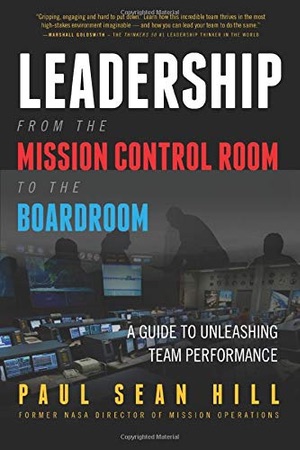Review: Leadership from the Mission Control Room to the Boardroomby Jeff Foust
|
| The leadership, he writes, was in a “management cloud” that had grown distant from the real-time morality that governed Mission Control itself. It led to an inefficient organization where divisions were stovepiped from one another, reticent to share their issues or resources with other divisions: make “no ripples in the pond.” |
But even organizations that can be competent at one level can be dysfunctional at another. That’s a central lesson in Leadership from the Mission Control Room to the Boardroom by Paul Sean Hill, who was director of Mission Operations at JSC from 2007 to 2014. Hill, who rose up through the ranks as a controller and flight director, says during his time at the agency controllers never lost sight of their purpose, to ensure the safety of astronauts and the successful completion of missions. They were guided by a “real-time morality” of spaceflight that required a combination of technical truth, integrity, and courage. Deviating from that, he said, would put lives in jeopardy.
The problem, he said, was at higher levels of management of the overall directorate. A bureaucracy had built up within Mission Operations over its first four decades as the organization grew to thousands of employees. The leadership, he writes, was in a “management cloud” that had grown distant from the real-time morality that governed Mission Control itself. It led to an inefficient organization where divisions were stovepiped from one another, reticent to share their issues or resources with other divisions: make “no ripples in the pond,” Hill summarized. Moreover, the Mission Operations leadership, promoted from within, thought it was the epitome of such organizations and had nothing to learn from others.
What changed, Hill writes, was the appointment of a director who came from outside the organization, Allen Flynt, in 2004. Flynt, an experienced manager, could clearly see the problems with how Mission Operations was run, but struggled to get them to change. (Hill, who says his outspoken nature had put his NASA career in jeopardy, became Flynt’s deputy, and then director when Flynt left the agency in 2007.) As Hill writes, “a management team comprised of top rocket science performers lost perspective and connection to our most fundamental purpose and values in practice.”
That management eventually came around to the need for change, particularly after visiting other organizations with similar mandates, from an airline operations center to utilities to commercial and military satellite control centers. Managers discovered, to their dismay, that these organizations excelled in their missions, and were ahead of Mission Operations in many respects. That opened the door, Hill argued, to broader changes in how the directorate was managed. The concepts of technical truth, integrity, and courage used in the day-to-day operations at Mission Control were adapted to transparency, value alignment, and engagement at the senior management level.
As the book’s title and subtitle suggest, the purpose of the book is intended to show a model for improving the leadership of any company or organization—if the venerated Mission Control can benefit from this approach, so can yours, the argument goes. (Hill, who left NASA in 2014 and is now an executive consultant, contacted me about the book last month after seeing an essay here on the importance of developing a space culture in the US military.) But even if you’re not trying to restructure a company, Leadership from the Mission Control Room to the Boardroom offers interesting insights into how even a high-performing organization like Mission Control can suffer management problems, and how those problems can be corrected.
Note: we are temporarily moderating all comments submitted to deal with a surge in spam.
